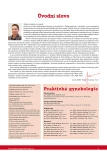The effect of docosahexaenoic acid on antenatal foetal development and postnatal child development
Authors:
T. Vrána
Authors‘ workplace:
Gynekologicko–porodnická klinika, Fakultní nemocnice Brno
Published in:
Prakt Gyn 2010; 14(1): 49-50
Category:
Unreviewed Post
Overview
Docosahexaenoid acid is important for development of the central nervous system in mammals. There is a growth spurt in the human brain during the last trimester of prengnancy and the first postnatal months, with a large increase in the cerebral content of arachidonic acid and docosahexaenoid acid. The fetus and the newborn infant depend on maternal supply of these acids. The child benefits of the high intake of this acid in women during pregnancy and lactation.
Key words:
docosahexaenoid acid – foetal mental development
Sources
1. Mikol D et al. Omega- 3 fatty- acid intake improves neurodevelopment in preterm girl. JAMA 2009; 301: 175– 182.
2. Helland IB, Smith L, Saarem K et al. Maternal supplementation with very- long‑chain n- 3 fatty acids during pregnancy and lactation augments children’s IQ at 4 years of age. Pediatrics 2003; 111(1): 39– 44.
3. Smithers L, Gibson R, McPhee A et al. Higher dose of docosahexaenoic acid in the neonatal period improves visual acuity of preterm infants, results of a randomized controlled trial. Am J Clin Nutr 2008; 88(4): 1049– 1056.
4. Koletzko B, Larqué E, Demmelmair H. Placental trasnfer of long‑chain polyunsaturated fatty acids (LC- PUFA). Perinatal Medicine 2007; 35: 5– 11.
5. Krabbendam L, Bakker E, Hornstra G et al. Relationship between DHA status at birth and child problem behaviour at 7 years of age. Prostaglandins Leukot Essent Fatty Acids 2007; 76(1): 29– 34.
6. Judge MP, Harel O, Lammi- Keefel CJ. Docosahexaenoic acid functional food during pregnancy benefits infant visual acuity at four but not six months of age. Lipids 2007; 42(2): 117– 122.
Labels
Paediatric gynaecology Gynaecology and obstetrics Reproduction medicineArticle was published in
Practical Gynecology

2010 Issue 1
Most read in this issue
- Margin status of conizations with histological finding carcinoma in situ
- ICTP marker and breast cancer with bone metastases – our experience
- Intrahepatic cholestasis of pregnancy – selected perinatal outcomes.
- Therapeutic options for assisted reproduction in patients with impaired ovarian reserve
